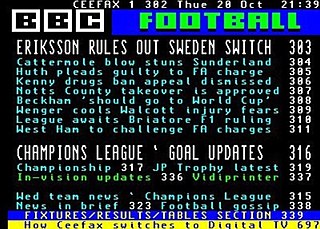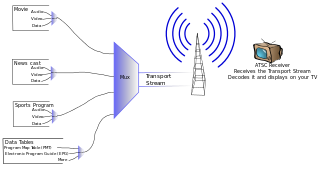
MPEG-2 is a standard for "the generic coding of moving pictures and associated audio information". It describes a combination of lossy video compression and lossy audio data compression methods, which permit storage and transmission of movies using currently available storage media and transmission bandwidth. While MPEG-2 is not as efficient as newer standards such as H.264/AVC and H.265/HEVC, backwards compatibility with existing hardware and software means it is still widely used, for example in over-the-air digital television broadcasting and in the DVD-Video standard.

The National Television System Committee (NTSC) developed the analog television color system that was introduced in North America in 1954 and stayed in use until digital conversion. It is one of three major analog color television standards, the others being PAL and SECAM. All the countries using NTSC are currently in the process of conversion, or have already converted to the ATSC standard, or to DVB, ISDB or DTMB.

Closed captioning (CC) and subtitling are both processes of displaying text on a television, video screen, or other visual display to provide additional or interpretive information. Both are typically used as a transcription of the audio portion of a program as it occurs, sometimes including descriptions of non-speech elements. Other uses have included providing a textual alternative language translation of a presentation's primary audio language that is usually burned-in to the video and unselectable.
Extended Display Identification Data (EDID) is a metadata format for display devices to describe their capabilities to a video source. The data format is defined by a standard published by the Video Electronics Standards Association (VESA).
Advanced Television Systems Committee (ATSC) standards are an American set of standards for digital television transmission over terrestrial, cable and satellite networks. It is largely a replacement for the analog NTSC standard and, like that standard, is used mostly in the United States, Mexico, Canada, and South Korea. Several former NTSC users, in particular Japan, have not used ATSC during their digital television transition, because they adopted their own system called ISDB.
Broadcast television systems are the encoding or formatting standards for the transmission and reception of terrestrial television signals. There were three main analog television systems in use around the world until the late 2010s: NTSC, PAL, and SECAM. Now in digital terrestrial television (DTT), there are four main systems in use around the world: ATSC, DVB, ISDB and DTMB.

EIA-608, also known as "line 21 captions" and "CEA-608", was once the standard for closed captioning for NTSC TV broadcasts in the United States, Canada and Mexico. It also specifies an "Extended Data Service", which is a means for including a VCR control service with an electronic program guide for NTSC transmissions that operates on the even line 21 field, similar to the TeleText based VPS that operates on line 16 which is used in PAL countries.
The MPEG user data feature provides a means to inject application-specific data into an MPEG elementary stream. User data can be inserted on three different levels:
Datacasting is the broadcasting of data over a wide area via radio waves. It most often refers to supplemental information sent by television stations along with digital terrestrial television, but may also be applied to digital signals on analog TV or radio. It generally does not apply to data which is inherent to the medium, such as PSIP data which defines virtual channels for DTT or direct broadcast satellite systems; or to things like cable modem or satellite modem, which use a completely separate channel for data.
MPEG transport stream or simply transport stream (TS) is a standard digital container format for transmission and storage of audio, video, and Program and System Information Protocol (PSIP) data. It is used in broadcast systems such as DVB, ATSC and IPTV.

Teletext, or broadcast teletext, is a standard for displaying text and rudimentary graphics on suitably equipped television sets. Teletext sends data in the broadcast signal, hidden in the invisible vertical blanking interval area at the top and bottom of the screen. The teletext decoder in the television buffers this information as a series of "pages", each given a number. The user can display chosen pages using their remote control. In broad terms, it can be considered as Videotex, a system for the delivery of information to a user in a computer-like format, typically displayed on a television or a dumb terminal. But that designation is usually reserved for systems that provide bi-directional communication, such as Prestel or Minitel.
Copy Generation Management System – Analog (CGMS-A) is a copy protection mechanism for analog television signals. It consists of a waveform inserted into the non-picture Vertical Blanking Interval (VBI) of an analogue video signal. If a compatible recording device detects this waveform, it may block or restrict recording of the video content.
Low-definition television (LDTV) refers to TV systems that have a lower screen resolution than standard-definition TV systems. The term is usually used in reference to digital TV, in particular when broadcasting at the same resolution as low-definition analog TV systems. Mobile DTV systems usually transmit in low definition, as do all slow-scan TV systems.

An ATSCtuner, often called an ATSC receiver or HDTV tuner, is a type of television tuner that allows reception of digital television (DTV) television channels that use ATSC standards, as transmitted by television stations in North America, parts of Central America, and South Korea. Such tuners are usually integrated into a television set, VCR, digital video recorder (DVR), or set-top box which provides audio/video output connectors of various types.
ATSC-M/H is a U.S. standard for mobile digital TV that allows TV broadcasts to be received by mobile devices.

The Advanced Television Systems Committee(ATSC) is an international, nonprofit organization developing technical standards for digital terrestrial television and data broadcasting. ATSC's 120-plus member organizations represent the broadcast, broadcast equipment, motion picture, consumer electronics, computer, cable, satellite and semiconductor industries.
High-definition television describes a television system providing a substantially higher image resolution than the previous generation of technologies. The term has been used since 1936, but in modern times refers to the generation following standard-definition television (SDTV), often abbreviated to HDTV or HD-TV. It is the current de facto standard video format used in most broadcasts: terrestrial broadcast television, cable television, satellite television and Blu-ray Discs.
Timed Text Markup Language (TTML), previously referred to as Distribution Format Exchange Profile (DFXP), is an XML-based W3C standard for timed text in online media and was designed to be used for the purpose of authoring, transcoding or exchanging timed text information presently in use primarily for subtitling and captioning functions. TTML2, the second major revision of the language, was finalized on November 8, 2018. It has been adopted widely in the television industry, including by Society of Motion Picture and Television Engineers (SMPTE), European Broadcasting Union (EBU), ATSC, DVB, HbbTV and MPEG CMAF and several profiles and extensions for the language exist nowadays.






